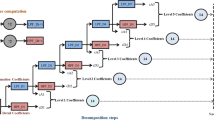Evaluation results of the developed method are presented. The mean energy value of the Hilbert spectrum of a speech signal obtained by the complementary ensemble empirical mode decomposition and the Hilbert–Huang transform is shown in different ranges depending on the choice of phrases formed by separate active organs of the speech apparatus.


Similar content being viewed by others
References
D. Chevalier and G. Mortuaire, “Acute disorder of speech. Dysphonia,” La Revue du Practicien, 11, 1217–1221 (2007).
Z. I. Anikeeva, I. V. Pleshkov, and A. A. Bondareva, “Clinical features of voice disorders in the population of a metropolis,” Vest. Otorinolaring.: Med. Nauch.-Prakt. Zh., 1, 14–21 (2007).
D. A. Yaroslavtseva and A. Yu. Tychkov, “Analytical review of the methods and algorithms for evaluating the state of vocal cords and the larynx,” Izmer. Monit. Upravl. Kontrol, 3, No. 1, 12–18 (2014).
V. G. Mikhailov and L. V. Zlatoustova, Measuring Speech Parameters, Radio i Svyaz, Moscow (1987).
I. Kushnir and M. Botbol, Patent 2314751 RF, “The system of analysis and imaging noise of the respiratory tract,” Izobret. Polezn. Modeli, 5 (2008).
I. V. Pleshkov, S. A. Filist, N. V. Krasnova, and Yu. A. Blinkov, Patent 2313280 RF, “A method of investigating the functional state of vocal cords,” Izobret. Polezn. Modeli, 16 (2006).
H. Weiping, “A novel pitch period detection algorithm based on HHT with application to normal and pathological voice,” Proc. Eng. Med. and Bio. Soc., IEEE-EMBS 2005: 27th Ann. Int. Conf., Shanghai, China (2006), pp. 4541–4544.
M. Kaleem, “Pathological speech signal analysis and classification using empirical mode decomposition,” Med. & Bio. Eng. & Comp., 51, No. 7, 811–821 (2013).
S. Gaston, T. Maria Eugenia, and L. R. Hugo, “Pathological Voice Analysis and Classification Based on Empirical Mode Decomposition,” Development of Multimodal Interfaces: Active Listening and Synchrony Lecture Notes in Computer Science, 5967, 364–381 (2010).
N. E. Huang, Shen Zheng, and R. L. Steven, “The empirical mode decomposition and the Hilbert spectrum for nonlinear and non-stationary time series analysis,” Proc. Roy. Soc. London A, 454, 903–995 (1998).
N. E. Huang and O. Attoh-Okine Nii, The Hilbert–Huang Transform in Engineering, Taylor and Francis, Philadelphia (2005).
A. Yu. Tychkov, O. N. Bodin, A. V. Kuz’min, et al., “Information-measurement system for pre-processing photofluorographs,” Izmer. Tekhn., 4, 42–53 (2011).
A. K. Alimuradov, “Speech signals filtering using the ensemble empirical mode decomposition method and the intrinsic mode functions energy assessment,” Int. J. Appl. Eng. Res., 10, No. 2, 3175–3185 (2015).
A. K. Alimuradov and A. Yu. Tychkov, “The use of the Hilbert–Huang transform for selecting informative features of speech signals,” Mezhdunar. Nauch.-Issl. Zh., 5-1, No. 12, 57–58 (2013).
A. K. Alimuradov and Yu. S. Kvitka, “The use of complementary ensemble empirical mode decomposition for the analysis of speech signals,” Izmer.. Monit. Upravl. Kontrol, 4, No. 10, 69–75 (2014).
J.-R. Yeh, J.-S. Shieh, and N. E. Huang, “Complementary ensemble empirical mode decomposition: A novel noise enhanced data analysis method,” Adv. Adapt. Data Analysis, 2, No. 2, 135–156 (2010).
A. Yu. Tychkov, A. K. Alimuradov, Yu. S. Kvitka, and D. A. Yaroslavtseva, Certificate of official registration of the database No. 2013621156, “Verified database of speech signals,” Progr. EVM, Bazy Dan., Topol. Integr. Skhem (2013).
N. P. Kornejchuk, Splines in Approximation Theory, Nauka, Moscow (1984).
R. C. Sharpley and V. D. Vatchev, Analysis of the Intrinsic Mode Functions, Industrial Mathematics Institute Department of Mathematics University of South Carolina, Columbia (USA) (2004) p. 31.
Author information
Authors and Affiliations
Corresponding author
Additional information
Translated from Izmeritel’naya Tekhnika, No. 5, pp. 26–29, May, 2016.
An erratum to this article can be found at http://dx.doi.org/10.1007/s11018-016-1030-1.
Rights and permissions
About this article
Cite this article
Tychkov, A.Y., Alimuradov, A.K. & Churakov, P.P. Adaptive Signal Processing Method for Speech Organ Diagnostics. Meas Tech 59, 485–490 (2016). https://doi.org/10.1007/s11018-016-0994-1
Accepted:
Published:
Issue Date:
DOI: https://doi.org/10.1007/s11018-016-0994-1




